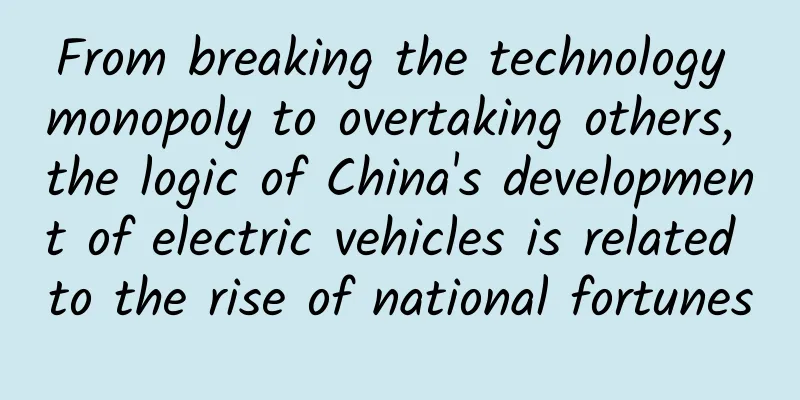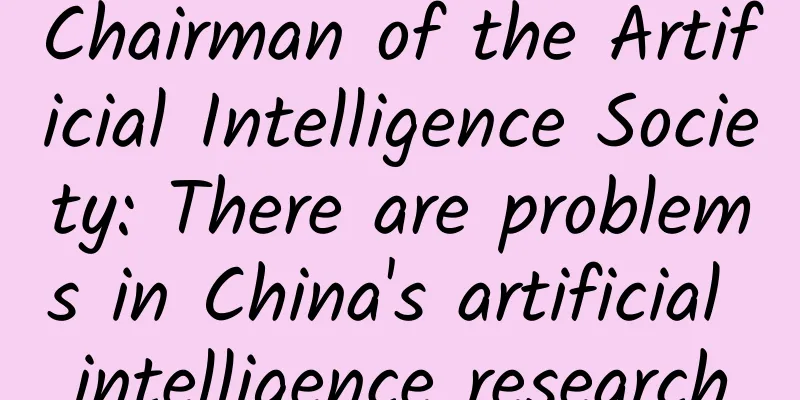From breaking the technology monopoly to overtaking others, the logic of China's development of electric vehicles is related to the rise of national fortunes

|
Industrial competition between China and the United States is unfolding in more dimensions. In the field of new energy vehicles, which is seen as the future, China and the United States have shown completely different choices in policy making and development trajectories, drawing two completely non-intersecting future curves. According to statistics, China is about to surpass the United States with 275 million cars, becoming the world's largest car owner. Among them, China's new energy vehicles account for 44% of the world's total, and the global automotive industry has officially entered the new energy era. From China's perspective, the emergence of new energy has helped us to overtake others in the automotive field, indirectly breaking the technological blockade of Europe, the United States and Japan for more than 100 years and achieving industrial independence. Breaking the blockade In the era of fuel vehicles, Europe, the United States and Japan's technological blockade and market monopoly on us in the automotive field are crazy. Take the ABS anti-lock braking technology that we are all very familiar with as an example. It is of great significance to the safety of emergency braking during driving. Europe and the United States have long since enacted law requiring ABS to be standard. However, ABS technology is monopolized by a few manufacturers such as Bosch and Continental, and the purchasing price for OEMs has remained high. In 2000, the country listed ABS as a key development project in the 15th Five-Year Plan. After going through untold hardships, Tsinghua University and Zhejiang Asia Pacific Group finally achieved a technological breakthrough in cooperation. However, before Chinese engineers could optimize ABS technology and the R&D costs were recovered, European and American companies took the initiative to reduce prices, and the prices were directly reduced from above the knee. Because imported products completely crushed domestic products in terms of quality and price, domestic ABS products were finally put into the grave. In this way, Europe and the United States have been reaping the benefits of ABS technology from 1936, when the Anti-Japanese War had not yet begun, until today. Another example is Audi's 40-year-old four-wheel drive system quattro, which achieves full-time four-wheel drive torque distribution through purely mechanical means. Due to its excellent performance, it once led to Audi cars being banned from rally races in the 1980s because its function was comparable to that of a plug-in. In the field of new energy vehicles, since the size of the motor is much smaller than that of the internal combustion engine under the same input power, it can be arranged near the wheel hub, simplifying the entire system. The torque distribution problem of full-time four-wheel drive can be achieved through an extremely simple software algorithm. In other words, the Audi Q5 needs to design extremely complex front and rear transmission systems, but on new energy vehicles, there is no need for traditional front and rear systems at all. This is just one technology used in fuel vehicles, and it is the tip of the iceberg. In fact, in the entire automotive industry, we are stuck with countless key technologies by Europe, the United States, and Japan. However, in the era of new energy, the fuel vehicle technology accumulated by Europe, the United States and Japan over hundreds of years has basically become obsolete, and they are now on the same starting line as Chinese manufacturers. It’s like China has not developed a complete credit card system, but with the support of mobile Internet, it has surpassed the whole world with mobile payment. By the same token, with the rapid development of new energy vehicles today, China's automobile industry has also gained an excellent opportunity to overtake others. Policy promotion For the automobile market with annual sales of nearly 100 million units, grasping the pulse of the industry's future is not only crucial for enterprises, but also a strategic issue that the country should plan in advance. Today, as countries have issued timetables for the withdrawal of fuel vehicles from the market, the technical reserves of new energy vehicles, the improvement of the industrial chain, the extensive construction of charging stations, and the sales volume of electric vehicles in the market are all indispensable. In this regard, China and the United States are like two sides of the same coin. China used extraordinary treatment to attract Tesla to build a factory in Shanghai. Not only did it give the green light in terms of policies, it even provided financial subsidies to consumers who purchased Tesla cars. The domestically produced Tesla Model 3 rolled off the production line half a year earlier than expected, quickly helping Musk open up the Chinese market. With the help of Tesla's electric car factory, which has countless fans around the world, China is expected to attract upstream and downstream companies in the global new energy vehicle industry chain to come to China, helping China to pave the way for the construction of the industry chain. Just like when Apple improved the foundry industry chain, it created Xiaomi's dream of selling a "fever" product at 1,999 yuan. As an interesting response, while Tesla's US factory is under construction, the US Senate and House of Representatives have reached an agreement to prohibit the use of federal funds to purchase Chinese buses and trains. This bill is directly aimed at two Chinese companies that have established subsidiaries in the US. One is CRRC, whose subsidiary is aggressively entering the US rail vehicle market; the other is BYD, whose subsidiary is selling electric buses in the US market. On the other hand, as supporting facilities for new energy vehicles, the importance of the construction of charging stations and charging piles is self-evident. Unfortunately, no matter from which perspective, building charging stations and charging piles is obviously not a cost-effective business. The construction of high-power charging piles of 100kW will inevitably involve the transformation of the power grid. After all, 1 or 2kW air conditioners often cause power outages in many old communities. After evaluation by the U.S. Energy Department, even if oil prices soar, this construction is still considered "economically irrational." For profit-seeking capital, "there are people who will do business that will get them killed, but no one will do business that will lose them money." In China, strengthening the construction of new infrastructure, promoting new energy vehicles, and building charging piles have been written into the government work report, which is the new infrastructure policy we are familiar with. All parts of the country have actively responded and implemented it. As of now, more than 20 provinces, cities and districts, including Beijing, Shanghai, Jiangsu and Shandong, have released investment plans for key projects in 2020. Among them, new infrastructure has become the most frequently appearing keyword. It is believed that the new infrastructure advocated by the country refers to areas centered on scientific and technological innovation and industrial upgrading, corresponding to industries with huge future incremental space, which will help unleash China's economic growth potential and enhance competitiveness over a long period of time. In addition to the existing operating companies, technology companies such as Huawei and Alibaba have also rushed into the construction of charging stations and charging piles. Of course, there is nothing wrong with the assessment of the US energy department. Among the large number of leading charging station construction companies emerging in China, only Teladian has achieved profitability in 2019 after five years of operation and an investment of 5 billion yuan. Without policy incentives, capital will be profit-seeking and short-sighted. A few years ago, after calculating the R&D costs and market risks, American capital decisively abandoned the research of 5G technology. Now it can only put pressure on its allies everywhere to ban Huawei's 5G equipment on the grounds of national security. In China, which is leading in 5G construction, it is unknown what applications will be implemented in the future and in which fields it will achieve leadership in mobile payments and short videos. In the field of new energy vehicles, the construction of charging stations and charging piles directly determines the range and severity of charging anxiety symptoms of electric car owners. Only when charging stations and charging piles are densely built can consumers feel confident buying electric vehicles; only when the number of electric vehicles is high enough can the builders of charging stations and charging piles achieve profitability. The two can promote each other and allow the new energy vehicle industry to enter a positive cycle. In this regard, China is undoubtedly the world leader. According to data from the China Society of Automotive Engineers, by the end of 2014, China had built 778 charging and swapping stations and 30,914 charging piles for electric vehicles. By 2019, China had 516,396 public charging piles and 35,849 charging stations, which has increased by dozens of times. It is reported that in 2019, the ratio of public charging piles between China and the United States was close to 8:1, and the number of charging piles in Beijing alone was basically the same as that in the entire United States. This year, the State Grid has gone a step further, investing 2.7 billion yuan in charging piles and building 78,000 new charging piles, a year-on-year increase of 35.5 times. Price Subsidy In addition to subsidies for the construction of charging stations and charging piles, direct subsidies for the sales price of new energy vehicles are also an important factor in attracting consumers to purchase electric vehicles. Although there have been many cases of new energy vehicle companies cheating on subsidies, with the introduction of a series of measures such as linking subsidies to driving range, the tide of subsidy fraud has been pushed away, and the naked car companies are exposed. The continuous decline in the price per unit capacity of batteries has allowed domestic electric vehicles to continue to gain favor with consumers even as new energy subsidies gradually decline. The "Notice of the Four Ministries on Improving the Financial Subsidy Policy for the Promotion and Application of New Energy Vehicles" issued by the Ministry of Finance, the Ministry of Industry and Information Technology, the Ministry of Science and Technology, and the National Development and Reform Commission stated that in addition to continuing to exempt purchase tax, the subsidy policy implementation period will be extended to 2022. The subsidy reduction for new energy vehicles will be smoothed in the next two years, and support will be provided for the development of new business models such as "vehicle-battery separation". However, in the United States, a paradoxical scene occurred. The fate of new energy vehicles was completely hijacked by the game between Trump and Biden. In 2010, the U.S. Congress passed a tax credit policy for electric car owners. Any automaker that produces electric cars can initially receive a subsidy of $7,500 per vehicle. However, after the automaker's cumulative sales of electric cars in the U.S. exceed 200,000, the subsidy reduction mechanism will be triggered. The subsidy will be reduced to $3,750 within six months, and will continue to decline to $1,875 in the next six months until the subsidy is reduced to zero. Tesla had already reached the 200,000-vehicle subsidy threshold in 2018, triggering the subsidy reduction mechanism. At the end of 2019, Tesla's electric vehicle sales in the United States plummeted by 27%. "Tesla's new energy vehicles are not yet able to compete with traditional fuel vehicles in the market at original prices," said Wiesenfelder, editor-in-chief of US media Cars.com. Therefore, Tesla and GM lobbied and pressured the US government to increase the number of electric vehicles that can enjoy tax credits. However, Trump clearly opposed this and said, "If this bill falls on my desk, I will tear it up." The fate of new energy vehicles is closely tied to the destiny of the United States. During the election, when Trump was in the upper hand, the clean energy sector led by the photovoltaic concept plummeted all the way; when Biden was leading in votes, the daily increases of JinkoSolar, Canadian Solar and other sectors were 28.44% and 11.96% respectively. The share prices of new energy vehicle concept stocks such as Tesla, GM, NIO, Xpeng Motors, and Li Auto in the US have also fluctuated with the election situation, like a roller coaster ride. Although Biden has won the election and the share prices of new energy vehicles have been pushed up, Biden has not yet entered the White House, and there has been no substantial progress on the bill to change the number of tax credits for electric vehicles. It remains an unknown whether new energy vehicles such as Tesla can continue to enjoy subsidies in the United States. Product Strength In contrast, in China, new energy vehicles represented by BYD, NIO, Xpeng, Wuling, and GAC have shown a flourishing trend, cooperating with the healthy domestic new energy ecology and winning the favor of consumers with excellent product strength. In terms of performance, many domestic electric vehicle models are no longer inferior to Tesla Model 3, and have even surpassed it in terms of interior quality and battery life. This is clearly reflected in the regional differences in electric vehicle purchases. In the past, car enthusiasts always believed that the high sales of new energy vehicles in China were largely due to purchase and driving restrictions in first-tier cities, which meant that consumers had no choice but to choose electric vehicles. However, Ma Chunsheng, deputy director of the Automobile Development Department of the First Division of the Equipment Industry Department of the Ministry of Industry and Information Technology, said: "This year's market structure shows that the proportion of individual consumers who choose new energy vehicles has increased significantly from 20% to 70%, and the proportion of purchases in cities without purchase restrictions has reached 60%, which shows that individual consumers have basically recognized new energy vehicles, even in the absence of purchase restrictions or driving restrictions." With the increasingly perfect construction of charging stations and charging piles, as well as far-sighted subsidy planning, China's new energy vehicle industry has entered a positive cycle of upward channel, and a large number of models with outstanding product strength have emerged this year. Despite the impact of the epidemic, subsidy reduction, and falling oil prices, it is still expected to achieve sales of 1.3 million vehicles, an increase of 8%, which is far beyond expectations. In the Biden era, China and the United States will usher in a new situation. However, no matter how the international situation changes, we will adhere to the path of technological innovation and industrial upgrading. Seizing the once-in-a-century major changes in the automotive industry is the best opportunity for the Chinese automotive industry to break through the technological blockade of Europe and the United States and achieve overtaking on the curve. As a winner of Toutiao's Qingyun Plan and Baijiahao's Bai+ Plan, the 2019 Baidu Digital Author of the Year, the Baijiahao's Most Popular Author in the Technology Field, the 2019 Sogou Technology and Culture Author, and the 2021 Baijiahao Quarterly Influential Creator, he has won many awards, including the 2013 Sohu Best Industry Media Person, the 2015 China New Media Entrepreneurship Competition Beijing Third Place, the 2015 Guangmang Experience Award, the 2015 China New Media Entrepreneurship Competition Finals Third Place, and the 2018 Baidu Dynamic Annual Powerful Celebrity. |
<<: A new beginning, BYD Auto announced a new logo on January 1
Recommend
With neither demand nor technology, Italy has placed all its hopes for new energy vehicles on China
Red wine, two Milans, a country that looks like a...
Luckin Coffee community operation skills!
After Luckin Coffee was suspended and delisted, i...
There are so many mosquito repellent products, which ones are the safe and effective mosquito repellent ingredients?
The weather is getting hotter, and there are more...
Detailed explanation of gamification operation methods!
There are many problems in the user operation gro...
2 pictures to help you understand Toutiao's recommendation system
The “predecessors” of recommendation systems In 2...
The first charging station of GAC Aion brand was completed, officially opening the era of energy ecology
On April 18, the first charging station of GAC Ai...
Can eggs be "resurrected"? In the era of traffic, how can we correctly understand the true science?
The biological blogger "Huzhang" who id...
Create short video IP in the first year of 5G and make your fans addicted to you
2019 is known as the first year of 5G. The arriva...
Guang'an Mini Program Agency Company, how much does it cost to be an agent for a flower mini program?
How much does it cost to be an agent of Guang'...
They killed 140,000 goats, and they said it was for ecological protection?
The gunmen on the two helicopters, armed with sho...
Users (fans) start to leave at an accelerated rate, what else can you do?
If you are extremely sensitive to user activity, ...
Fan Deng Reading User Growth System!
Fan Deng’s annual revenue from reading books has ...
The most useful "bucket waist" in the world can hold 2 tons of water!
In the magical nature, there are many kinds of cr...
11 hair dryer reviews: Shocking! I bought fake brand products in a live broadcast room! How to distinguish?
Here’s what happened: On this year’s Double Eleve...
The outlook for Android is not optimistic. The deployment rate of the new version has dropped by 20%.
According to foreign media reports, compared with...









